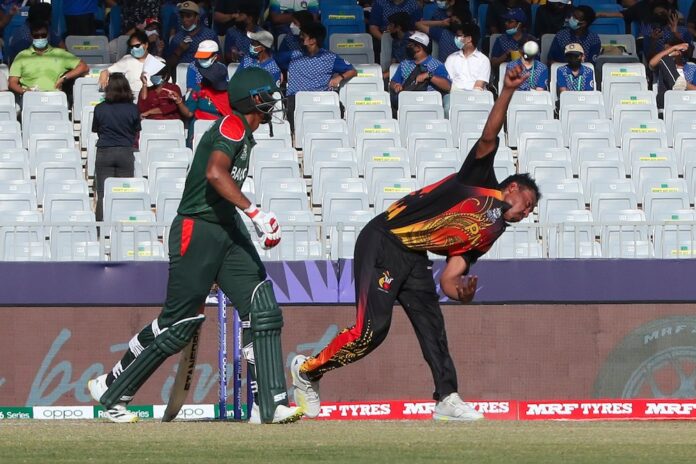The Indian Premier League concluded on Oct.15 without any apparent major hitches caused by the coronavirus disease or mental health issues.
The T20 World Cup opened on schedule, rather romantically, with Papua New Guinea appearing for the first time only to be soundly beaten by Oman.
England announced their squad to tour Australia, only to be condemned by parts of the press as unimaginative, not good enough and likely to be trounced, a view shared gloatingly down-under.
Unimaginative was also the verdict passed on the England and Wales Cricket Board (ECB)’s decision to restore its domestic four-day County Championship to a two divisional structure, comprising teams in the positions in which they ended the 2019 season.
Taken together, these outcomes provide the impression that normality has been restored to the world of cricket. However, dig a little deeper and some shifting plates may be discerned under the landscape. The most obvious one is the influence of the T20 format.
Whilst the IPL is its glittering epitome, the delayed return of the scheduled 2020 World Cup, hard on the heels of the IPL, will extend T20’s exposure for longer than normal. It will also supply a benchmark for its progress since the 2016 World Cup in terms of skills and tactics. Prior to the pandemic, nine countries/regions held International Cricket Council recognized T20 competitions, and three more are planned to start in 2022. Since 2016, both the Pakistan Super League and the Big Bash in Australia have grown in quality and appeal.
Apart from the format, these tournaments share two common features — the ability to attract money and, partly because of this, the ability to attract players from a wide range of countries, based upon a bidding system that values each player according to perceived ability. The rewards are now staggering.
The total prize money for the T20 World Cup is $5.6 million. There will be $1.6 million for the winning team and $0.8 million for the runners-up. The losing semi-finalists will receive $0.4 million each, with the balance of $2.4 million being shared between group stage winners and those who are knocked out along the way.
In the 2021 IPL, the winners received around $2.65 million, the runners-up $1.69 million, and the third and fourth placed teams $1.16 million. On top of this, the players receive salaries with the top five being in a range of $2-2.4 million in 2021. The stark conclusion is that the top players in the IPL earn more than the winning team in the T20 World Cup, and that the financial reward for winning the IPL is greater than for winning the T20 World Cup. Taken together, the rewards on offer are a bonanza.
Contrast these riches, for example, to the financial state of English cricket. The ECB’s income is generated via broadcast rights deals, sponsorship from commercial partners, ICC distributions, ticket sales and sundry income. In the year ending Jan. 31, 2021, it reported an income of $290 million and a pandemic-induced loss of $22.6 million, which dramatically reversed the previous year’s profit of $9.1 million, causing a sharp fall in its cash reserves to $3.1 million.
As a non-profit-making organization, the ECB distributes its income in pursuit of its mission to manage and develop every form of cricket for men and women, boys and girls, from the playground to the Test arena. Almost 44 percent of the income goes directly to cricket organizations, including the 18 first-class counties. Fourteen percent is spent in supporting each of four areas — the running and growth of cricket from the grassroots up; running the England Men’s, Women’s and Disability teams; central activities, such as marketing and, in the current cycle, its new competition, The Hundred, which has been explored in previous columns.
Professional cricket is organized through the County Championship structure. The counties have the responsibility for developing talent, ultimately producing cricketers who can perform at the highest level across the various formats.
A review of the finances of the 18 counties would show that, for most, there is a heavy dependency on the ECB distribution for survival. There is also a clear divergence between the financial health of those counties who host international matches and those who do not. The structure of county cricket and its dependence on central funds to maintain its current state has attracted much criticism, particularly in terms of the way in which the counties use the money to develop both the game and alternative income sources within their boundaries.
How enviously must English cricket cast its eyes at the wealthy, independent Board of Control of Cricket in India. Although it, too, has suffered a loss of income because of the pandemic, the completion of the IPL will ensure a recovery to previous levels and beyond. In 2019-2020, the BCCI’s annual income is thought to have been some $535 million. Almost two-thirds of this comes from the IPL, a quarter from bilateral cricket with other nations and 10 percent from its annual share of ICC revenues, which are derived from the ICC’s own media and sponsorship income streams. In 2022, two more franchises will be added to make a 10 team IPL tournament, creating further wealth.
The economics of world cricket have become highly skewed and look set to become even more so. This is largely because of the phenomenal success of T20 in cricket-mad India that has generated previously unseen revenue. This has allowed India’s cricketing ambitions to become more expansionary and has encouraged copycat tournaments to emerge.
In turn, the lure of high rewards and the attraction of the format in emerging countries that have a dearth of either facilities, resources or time, such as Papua New Guinea, is leading T20 to assume an increasingly prominent position in cricket’s landscape. This powerful position, coupled with the financial clout of India, can only lead, surely, to further changes in the way that the game is structured and financed.

